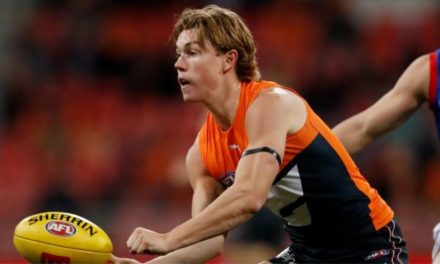Premiership drought-breakers clockwise from left: Sydney (2005), Geelong (2007), Bulldogs (2016) and Richmond (2017).
The football world is in a state of apoplexy over score reviews and various other matters relating to how the game is being officiated.
Whilst there are genuine concerns over the unprofessional manner in which the score review system has been implemented and now currently operates, I am reminded of the words of Mike Sheahan at the time of his retirement from the position of chief football writer at the Herald Sun.
Mike was asked how he felt the AFL had been run during his time covering the game. His response was that whilst the AFL had not always got things right relating to the day-to-day running of the game, they had been judicious in their handling of the major issues. In short, he said the AFL didn’t always get the small things right, but they were pretty good when it came to the big ones.
Smart man, Mike. It’s easy to become infuriated with ongoing weekly problems such as the score review, the ever-changing manner in which player suspensions are processed or unannounced changes to how umpires interpret the rules of the game.
Throw in 2019 bugbears such as policing of fan behaviour and the folly that is overseas expansion through the playing of premiership season matches on foreign soil and you might get the impression the AFL is being run by Basil Fawlty and scores of Manuels.
But if you do feel that way, I think you may be suffering a textbook case of not being able to see the forest for the trees.
True, there are unresolved issues that aggravate on a weekly basis, but if you take a deep breath and look at the big picture, I’m sure you’d be more than comfortable with what you see.
The AFL is a passionately-followed competition with an engineered evenness to ensure that passion doesn’t wane. It has implemented, and still operates, both a salary cap and player draft that work in tandem to give all participating clubs a realistic opportunity of being crowned champions within a 10-year window.
Just look at the current state of play in the AFL. Only one game separates seven sides in and outside the top eight. Below the lowest-ranked of those sides, St Kilda in 14th, is Hawthorn, Melbourne and Carlton. Those three clubs are hardly easybeats on present form, and even bottom of the ladder Gold Coast has been highly competitive, despite the exodus of a number of its top players at the end of 2018.
Added to the present even season is the spread of premiers this millennium. The unpredictable nature of the competition has seen Geelong, Sydney, Richmond and the Western Bulldogs all break premiership droughts since 2000. During that time there were also grand final appearances for fellow drought sufferers Melbourne and St Kilda, as well as a first grand final for Fremantle.
If you find all of the above ancient history, then go back just one year for proof of the egalitarian nature of the competition. In 2017, West Coast finished eighth and Collingwood ended the year 13th. One year on, the two clubs meet in the grand final.
Even competition year in, year out, and a broad spread of title winners. Little wonder then that so many other major sporting bodies have made public their envy of the level playing field provided by the AFL.
The most obvious imbalance of power at club level occurs in the round ball version of football. Major leagues such as the EPL of England, La Liga in Spain and the Serie A of Italy may have 20 or more competing clubs, but in reality the title of champion is winnable by only a handful of the richest organisations in each county.
In recent times, FIFA has implemented a total spending limit on all clubs globally. But the underlying problem has not been solved because the cap is still large enough to ensure the status quo remains.
There are exceptions to every rule, and some point to Leicester City winning the EPL title in 2015-16 as evidence that any club can indeed walk away with a major title in world football.
Unfortunately, that extraordinary feat by the 500/1 outsiders didn’t prove to be the fillip to smaller clubs optimists had hoped. All it did was steel the resolve of the mega-clubs. To ensure it would never happen again, the “big boys” loosened their belt-buckles, increased major signings and plundered the smaller clubs of their best players.
Needless to say, there has been no repeat performance by a minnow in any major football league around the globe.
Another “big one” that the AFL has got right in recent years is shoring up the long-term survival of all competing clubs.
This was not always the case. Supporters of St Kilda, Western Bulldogs, Hawthorn, Melbourne and North Melbourne don’t need to delve back too far in their memories to recall what is was like living with the fear of losing the team they loved.
The AFL publicly stated it was no longer pursuing the option of relocating or merging clubs after failing in its attempt to move North Melbourne to the Gold Coast to become the Gold Coast Kangaroos. In what was viewed as a public relations disaster, the AFL came across as heartless business barons willing to dismantle a traditional club simply to fill their already rich coffers.
Since that time, the league has implemented a fund which helps clubs that are struggling financially to meet their day-to-day expenses. The fund guarantees the long-term survival of all current teams and surely stands as a major achievement. If you think otherwise, just ask an old Fitzroy fan.
Bottom line, the AFL is a sporting competition where every club has a long-term future that includes the realistic opportunity of one day being crowned the champions. Yes, there are weekly aggravations that drive us all batty, but surely that’s a small price to pay when you look at the big picture.












“…envy of the level playing field provided by the AFL”
That’s a Furphy, Finey.
Since 2000, six teams – Brisbane, Collingwood, Geelong, Hawthorn, Sydney or West Coast -have shared 15 of the 19 flags, and only TWO grand finals since then didn’t include one of those six (2000 and 2017).
We have seen two teams win three-peats, and another team win three in five years.
If you’re not a fan of those six, the last 19 seasons haven’t been that flash with slim pickings. And 2019 looks good for three of those five teams – yet again – who are holding down the top three spots at the moment.
So of the 38 grand final spots in the last 19 years, 27 of them were taken by just six teams.
Looking at this the other way, 12 teams have fought over the remaining 11 other grand final spots, and managing to eke out just three flags (2000, 2004, 2017).
Read that again and let it sink in. Two thirds of the competition, 12 teams, have been able to win only three out of the last 19 flags.
That’s not a level playing field. We delude ourselves if we think it is.